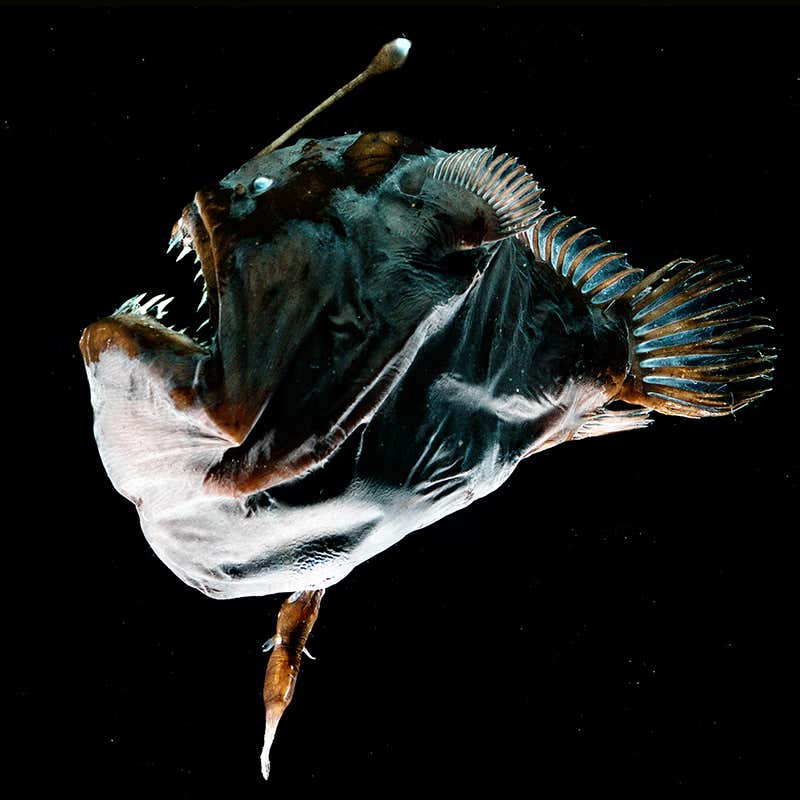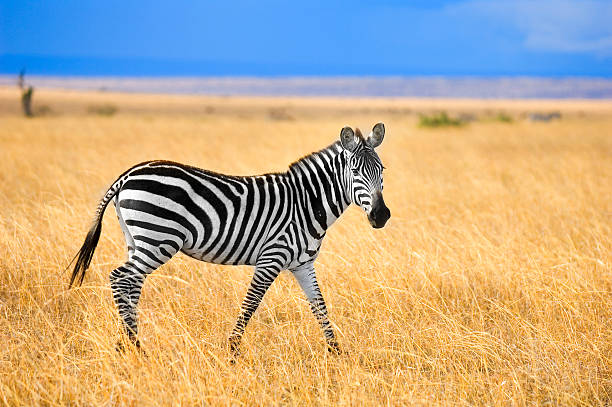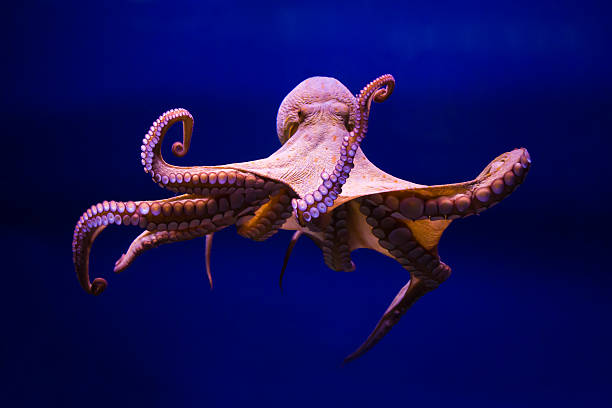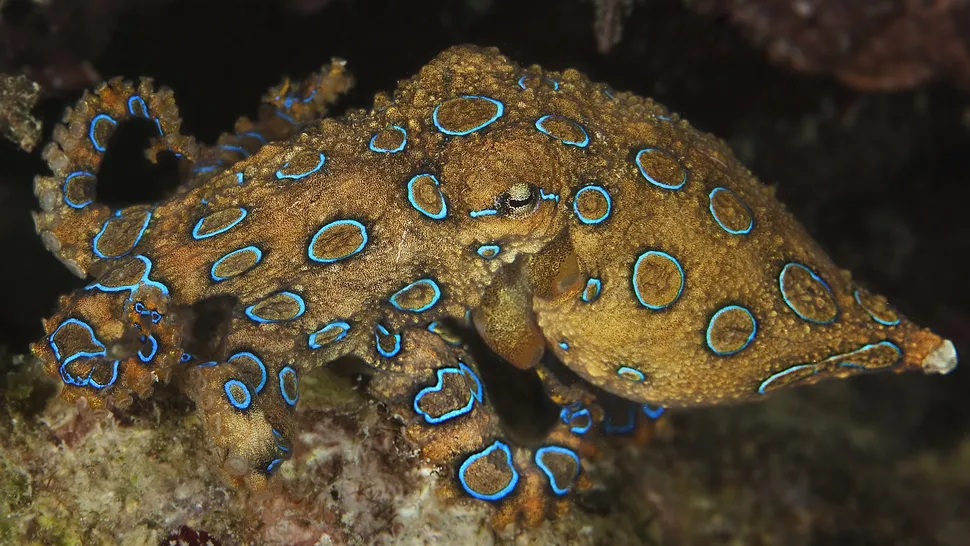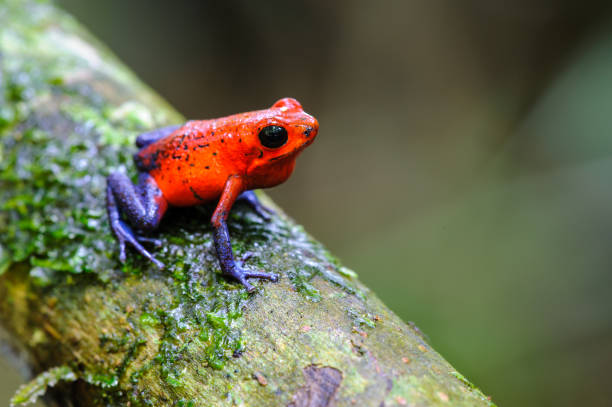Far below the sunlit waves, beyond the reach of light and warmth, lies a realm of perpetual night — a vast and silent expanse known as the deep sea. It is a place where pressure crushes like the weight of mountains, where temperatures hover near freezing, and where sunlight has never touched. And yet, in this alien world, life thrives in the most astonishing forms imaginable.
The deep ocean is Earth’s last great frontier. More than 80 percent of it remains unexplored, and every expedition reveals new, breathtaking species that defy our understanding of life itself. These creatures are not the monsters of myth, but the masterpieces of evolution — adapted to darkness, pressure, and scarcity with exquisite precision.
What follows is a journey into that otherworldly realm — a descent into the cold, crushing depths to meet ten deep sea creatures so bizarre, so surreal, that they seem to belong to another planet.
1. The Anglerfish – The Demon of the Deep
The anglerfish is the very embodiment of nightmare beauty — a creature so strange that even its own mate becomes part of its body. Found thousands of meters below the ocean surface, the anglerfish is known for the eerie glow that dangles from its head like a living lantern.
That glowing lure, called an esca, contains bioluminescent bacteria that emit light through chemical reactions. In a world without sunlight, light is power — and the anglerfish uses it to deadly effect. Small fish and crustaceans, drawn to the glow, swim close enough for the anglerfish’s massive jaws to snap shut, devouring prey in an instant.
Perhaps even more astonishing is its mating ritual. The male anglerfish, tiny compared to the female, bites into her body — and never lets go. Over time, he fuses with her flesh, losing his eyes, fins, and internal organs until he becomes nothing more than a living appendage that provides sperm on demand.
It’s a love story as haunting as it is fascinating — a macabre dance of survival in the deep’s eternal dark.
2. The Giant Squid – The Phantom Leviathan
For centuries, sailors spoke of monstrous tentacled beasts rising from the depths to drag ships into the sea. Those legends, dismissed as tall tales, turned out to be rooted in truth. The giant squid (Architeuthis dux) is very real — and it’s one of the largest invertebrates on Earth.
Reaching lengths of up to 43 feet (13 meters), the giant squid is a creature of legend made flesh. With eyes the size of dinner plates — the largest eyes in the animal kingdom — it can detect even the faintest shimmer of light in the abyss. Its tentacles are lined with suction cups armed with serrated rings, capable of gripping prey with terrifying strength.
Despite its size, this elusive giant has never been captured alive in its natural habitat until recent years. In 2012, scientists filmed one in the wild for the first time off Japan’s Ogasawara Islands. The footage revealed a creature both graceful and formidable — its long arms flowing like ribbons through the black water, its massive body pulsing with subtle, alien life.
The giant squid’s mysteries remain largely unsolved. How does it hunt? How intelligent is it? The answers lie somewhere in the deep — where myth and biology blur into one haunting truth.
3. The Goblin Shark – The Living Fossil
If the deep sea had a monster from a prehistoric nightmare, it would be the goblin shark (Mitsukurina owstoni). Often called a “living fossil,” this strange shark has changed little in 125 million years — a survivor from an ancient world that has long vanished.
The goblin shark’s most striking feature is its terrifying, protruding jaws. Normally tucked beneath its long, flattened snout, the jaws can shoot forward like a spring-loaded trap when prey approaches. In a split second, its needle-like teeth snatch up fish, squid, and crustaceans before retracting again — a perfect adaptation for ambush hunting in darkness.
Its translucent pink skin reveals blue veins beneath, making it look more like a creature of nightmares than a real animal. It lives at depths of up to 4,000 feet (1,200 meters), where light cannot reach, and its sluggish movements belie its lethal efficiency.
The goblin shark is a relic of deep time, a living window into Earth’s evolutionary past — a reminder that the ocean remembers everything, even the ghosts of its earliest hunters.
4. The Barreleye Fish – The Transparent Wonder
Imagine a fish with a clear, dome-shaped head through which you can see its glowing green eyes gazing upward. It sounds like science fiction, yet it exists — the barreleye fish (Macropinna microstoma), one of the strangest creatures ever discovered.
Living at depths around 2,500 feet (750 meters), the barreleye’s transparent head allows it to look through its own skull. Inside, its tubular eyes rotate within the dome, scanning for prey silhouetted against the faint glow of the surface.
For decades, scientists couldn’t understand how this fish saw its world — its eyes seemed to point straight up. But in 2009, high-definition submersible cameras revealed the secret: the eyes can pivot forward when feeding, allowing the barreleye to look both above and ahead.
Its clear head protects those sensitive eyes from the stings of siphonophores — long, jelly-like predators whose tentacles the barreleye often steals food from. In the twilight of the deep, this see-through fish is both a marvel of adaptation and a haunting reminder of how evolution crafts the extraordinary from the impossible.
5. The Giant Isopod – The Deep Sea Armadillo
Imagine a woodlouse — the little “roly-poly” bugs found in gardens — but the size of a cat. That’s the giant isopod (Bathynomus giganteus), one of the deep sea’s most bizarre scavengers.
Living on the ocean floor, sometimes 7,000 feet (2,000 meters) below the surface, giant isopods roam the dark seafloor in search of carcasses that sink from above — dead whales, fish, and squid. Their armored shells and spiny legs make them look like relics from another age, which, in a way, they are.
These creatures are distant relatives of crabs and shrimp, but they’ve evolved to survive in extreme scarcity. They can go years without eating, slowing their metabolism to nearly nothing, then gorge themselves when a meal finally arrives.
When scientists first pulled one up from the Gulf of Mexico in the late 19th century, they could hardly believe what they were seeing — a deep-sea arthropod the size of a football. Yet in the cold, crushing dark of the abyss, gigantism is common. For the giant isopod, size is survival — a way to store energy, withstand pressure, and endure hunger in a world where food is rare.
6. The Vampire Squid – The Shadow with Fire
Its name alone evokes gothic horror — but the vampire squid (Vampyroteuthis infernalis) is more mystery than menace. Its scientific name literally means “vampire squid from hell,” yet this creature is delicate, gentle, and utterly unique.
Drifting through the black depths of the oxygen-minimum zones, where few animals can survive, the vampire squid has evolved for efficiency. Its dark red body, webbed arms, and glowing blue eyes give it an unearthly beauty, like a creature woven from shadows and starlight.
Despite its name, it doesn’t drink blood. Instead, it feeds on “marine snow” — the slow rain of organic debris that drifts down from the surface. Using long, sticky filaments, it gathers these tiny particles and rolls them into nutritious balls.
When threatened, the vampire squid turns its body inside out, wrapping itself in its webbed arms to reveal rows of cirri that look like fangs. Then it ejects a cloud of bioluminescent mucus, sparkling like glittering smoke before vanishing into the dark.
It is a master of illusion — a living ghost that turns fear into survival, and darkness into light.
7. The Dumbo Octopus – The Deep Sea Angel
If there is a creature that could melt hearts even in the cold abyss, it’s the Dumbo octopus (Grimpoteuthis spp.). Named after Disney’s beloved elephant because of its ear-like fins, the Dumbo octopus is a gentle, otherworldly being that glides through the depths with serene grace.
Living as deep as 13,000 feet (4,000 meters), it is the deepest-dwelling of all octopus species. Its gelatinous body and fins allow it to “fly” through the water rather than jet like most octopuses.
Dumbos don’t hunt aggressively. Instead, they hover above the seabed, using their webbed arms to capture small crustaceans and worms. Their peaceful, floating motion makes them look almost angelic — a ballet dancer of the deep sea.
Despite their delicate appearance, they are perfectly adapted to crushing pressure and freezing darkness. Their quiet existence in the abyss is a gentle reminder that not all life in the deep is monstrous; some of it is profoundly beautiful.
8. The Fangtooth Fish – The Demon with a Bite
Few creatures look as terrifying as the fangtooth (Anoplogaster cornuta) — a small but fearsome fish with teeth so large they can’t fit in its mouth.
Growing only about six inches long, the fangtooth is proof that size means little in the deep. Its fangs are proportionally the largest of any fish, curving upward from its jaw like needles. When its mouth closes, special pockets in its skull prevent the teeth from piercing its own brain.
Despite its monstrous appearance, the fangtooth is surprisingly timid. Living up to 16,000 feet (5,000 meters) deep, it hunts by sensing vibrations and shadows rather than sight. Its body is built for endurance — compact, muscular, and nearly bulletproof against pressure.
In darkness absolute, the fangtooth’s nightmare visage is not about evil, but efficiency. It’s a survivor — fierce, elegant, and honed by millions of years to thrive where almost nothing else can.
9. The Gulper Eel – The Living Balloon
Of all deep-sea oddities, few are as jaw-droppingly bizarre as the gulper eel (Eurypharynx pelecanoides). With its enormous, pouch-like mouth, the gulper eel looks like a creature designed by imagination itself.
Its jaws can open wide enough to swallow prey almost as large as itself — not because it’s a ferocious hunter, but because in the deep, you never know when the next meal will come. Its massive mouth acts like a net, scooping up shrimp and small fish in great gulps.
The gulper eel’s tail ends in a glowing, bioluminescent organ, which it uses as a lure to attract prey. When light flickers in the abyss, curious creatures approach — only to meet the yawning, balloon-like mouth of the waiting predator.
Despite its frightening anatomy, the gulper eel is a fragile creature. Its paper-thin bones and delicate body are made for floating, not fighting. Seen alive, it moves like a drifting shadow — graceful, silent, and utterly unreal.
10. The Yeti Crab – The Furry Farmer of the Deep
Discovered only in 2005 near hydrothermal vents in the South Pacific, the Yeti crab (Kiwa hirsuta) is one of the ocean’s newest and strangest inhabitants. Covered in silky, white “fur,” it looks almost mythical — like a creature from a fairy tale that wandered into the deep.
But those hairs, or setae, serve a brilliant purpose. They house bacteria that detoxify poisonous minerals emitted by the vents. In return, the Yeti crab “farms” these microbes, waving its claws gently in the chemical-rich water to feed them — and then eats the bacteria it grows.
This symbiotic relationship allows the crab to thrive in a place where life should not exist. Around it, black smoke pours from fissures in the Earth’s crust, superheated to hundreds of degrees Celsius. Yet the Yeti crab moves calmly through the shimmering gloom, proof that even in the harshest inferno, life finds a way.
It is not a monster, but a miracle — a living testimony to evolution’s endless creativity.
The Science of Survival in the Deep
The creatures of the abyss share one defining trait: adaptation. Where pressure is over a thousand times greater than at the surface, where food is scarce and light nonexistent, they have evolved extraordinary ways to live.
Bioluminescence — light made by life — is one of their greatest tools. More than 90 percent of deep-sea species use it for hunting, defense, or communication. Chemical symbiosis, like the Yeti crab’s bacterial farming, lets life survive in toxic conditions. Gigantism, transparency, and slow metabolisms are other common traits, each tailored to the crushing silence of the deep.
The deep ocean is not barren — it’s teeming with strange vitality. It’s a place where beauty and horror coexist, where creatures shine like stars in eternal night, and where life thrives against all odds.
Humanity’s Window into the Unknown
Despite our technology, we’ve explored only a fraction of the deep. The Mariana Trench, the world’s deepest point, remains largely uncharted. Each dive reveals new species — delicate jellyfish that shimmer like fire, worms that feed on bones, and creatures that defy classification.
The deep sea reminds us that we are still beginners in understanding our own planet. Every discovery humbles us. Every glowing fish, every silent predator, whispers a truth older than time: life is unstoppable, ingenious, and infinitely strange.
The Final Descent
To gaze into the deep sea is to look into the soul of the Earth itself — a realm untouched by sunlight yet radiant with its own light. The creatures that dwell there are more than curiosities; they are living poems, written in the language of survival and wonder.
In their strange forms and eerie grace, we see the story of life’s resilience — that even in darkness, beauty blooms. The abyss is not empty; it’s alive. And somewhere, far below the waves, new wonders are waiting — unseen, unknown, and unimaginable.
